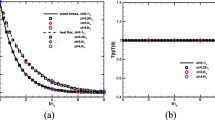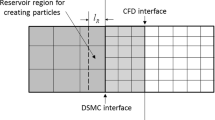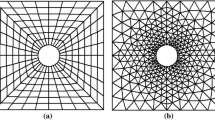Abstract
The goal of this work is to build up the capability of quasi-particle simulation (QuiPS), a novel flow solver, such that it can adequately model the rarefied portion of an atmospheric reentry trajectory. Direct simulation Monte Carlo (DSMC) is the conventional solver for such conditions, but struggles to resolve transient flows, trace species, and high-level internal energy states due to stochastic noise. Quasi-particle simulation (QuiPS) is a novel Boltzmann solver that describes a system with a discretized, truncated velocity distribution function. The resulting fixed-velocity, variable weight quasi-particles enable smooth variation of macroscopic properties. The distribution function description enables the use of a variance-reduced collision model, greatly minimizing expense near equilibrium. This work presents the addition of a neutral air chemistry model to QuiPS and some demonstrative 0D simulations. The explicit representation of internal distributions in QuiPS reveals some of the flaws in existing physics models. Variance reduction, a key feature of QuiPS, can greatly reduce expense of multi-dimensional calculations, but is only cheaper when the gas composition is near chemical equilibrium.































Similar content being viewed by others
References
Baker, L., Hadjiconstantinou, N.: Variance reduction in particle methods for solving the boltzmann equation. In: ASME 4th International Conference on Nanochannels, Microchannels, and Minichannels, American Society of Mechanical Engineers, pp 377–383 (2006)
Bergemann, F., Boyd, I.: New discrete vibrational energy model for the direct simulation monte carlo method. In: RGD: Proceedings of the 18th International Symposium on Rarefied Gas Dynamics, AIAA, Vancouver, Canada, pp 174–183 (1992)
Bird, G.: Molecular Gas Dynamics and the Direct Simulation of Gas Flows. Oxford University Press (1994)
Bird, G.: Setting the post-reaction internal energies in direct simulation monte carlo chemistry simulations. Phys. Fluids 24(12), 127104 (2012)
Boyd, I.: Relaxation of discrete rotational energy distributions using a monte carlo method. Phys. Fluids 5, 2278–2286 (1993)
Boyd, I., Schwartzentruber, T.: Nonequilibrium Gas Dynamics and Molecular Simulation. Cambridge University Press (2017)
Chen, S., Xu, K., Lee, C., Cai, Q.: A unified gas kinetic scheme with moving mesh and velocity space adaptation. J. Comput. Phys. 231(20), 6643–6664 (2012)
Clarke, P.: A discrete velocity method for the boltzmann equation with internal energy and stochastic variance reduction. PhD thesis, The University of Texas at Austin (2015)
Clarke, P., Varghese, P., Goldstein, D.: A low noise discrete velocity method for the boltzmann equation with quantized rotational and vibrational energy. J. Comput. Phys. 352, 326–340 (2018)
Cruden, B., Brandis, A.: Measurement of radiative nonequilibrium for air shocks between 7 and 9 km/s. J. Thermophys. Heat Transf. 34(1), 154–180 (2020)
Gordon, S., McBride, B.: Thermodynamic data to 20,000 k for monatomic gases. Technical report, National Aeronautics and Space Administration (1999)
Haas, B., Boyd, I.: Models for direct monte carlo simulation of coupled vibration-dissociation. Phys. Fluids A Fluid Dyn. 5(2), 478–489 (1993)
Haas, B., McDonald, J., Dagum, L.: Models of thermal relaxation mechanics for particle simulation methods. J. Comput. Phys. 107, 348–358 (1993)
Haas, B., Hash, D., Bird, G., Lumpkin, F., Hassan, H.: Rates of thermal relaxation in direct simulation monte carlo methods. Phys. Fluids 6, 2191–2201 (1994)
Higdon, K.: Monte carlo sensitivity analyses of dsmc parameters for ionizing hypersonic flows. PhD thesis, The University of Texas at Austin (2018)
Kolobov, V., Arslanbekov, R., Frolova, A.: Boltzmann solver with adaptive mesh in velocity space. AIP Conf. Proc. Am. Instit. Phys. 1333, 928–933 (2011)
Levine, R.: Molecular Reaction Dynamics and Chemical Reactivity. Oxford University Press, USA (1987)
Lumpkin, F., Haas, B., Boyd, I.: Resolution of differences between collision number definitions in particle and continuum simulations. Phys. Fluids 3, 2282 (1991)
Millikan, R., White, D.: Systematics of vibrational relaxation. J. Chem. Phys. 39, 3209–3213 (1963)
Morris, A., Varghese, P., Goldstein, D.: Monte carlo solution of the boltzmann equation via a discrete velocity model. J. Comput. Phys. 230(4), 1265–1280 (2011)
Oblapenko, G., Goldstein, D., Varghese, P., Moore, C.: Modeling of ionized gas flows with a velocity-space hybrid boltzmann solver, submitted (2021)
Pan, T., Subramaniam, S., Kondur, C., Stephani, K.: A state-resolved dsmc recombination model with orbiting-pair cross-sections. In: AIP Conference Proceedings, AIP Publishing LLC, vol 2132, p 070017 (2019)
Park, C., Menees, G.: Odd nitrogen production by meteoroids. J. Geophys. Res. Oceans 83(C8), 4029–4035 (1978)
Parker, J.: Rotational and vibrational relaxation in diatomic gases. Phys. Fluids 2, 449–462 (1959)
Plimpton, S., Moore, S., Borner, A., Stagg, A., Koehler, T., Torczynski, J., Gallis, M.: Direct simulation monte carlo on petaflop supercomputers and beyond. Phys. Fluids 31(8), 086101 (2019)
Poondla, Y.: Modeling reactive rarefied systems with a novel quasi-particle boltzmann solver. PhD thesis, The University of Texas at Austin (2020)
Radtke, G., Hadjiconstantinou, N., Wagner, W.: Low-noise monte carlo simulation of the variable hard sphere gas. Phys. Fluids 23(3) (2011)
Sekaran, A., Varghese, P., Goldstein, D.: An analysis of numerical convergence in discrete velocity gas dynamics for internal flows. J. Comput. Phys. 365, 226–242 (2018)
Tcheremissine, F.: Solution to the Boltzmann kinetic equation for high speed flows. Comput. Math. Math. Phys. 46(2), 315–329 (2006)
Varghese, P.: Arbitrary post-collision velocities in a discrete velocity scheme for the Boltzmann equation. In: Proceedings of the 25th International Symposium on Rarefied Gas Dynamics, AIP Conference Proceedings, St. Petersburg, Russia (2006)
Vincenti, W., Kruger, C.: Introduction to Physical Gas Dynamics. Krieger Publishing Company, Malabar, FL (1965)
Wilson, T., Pan, T., Stephani, K.: State-to-state dissociation and recombination modeling in dsmc using quasi-classical trajectory calculations for o+ o2. In: 2018 AIAA Aerospace Sciences Meeting, p 1487 (2018)
Author information
Authors and Affiliations
Corresponding author
Ethics declarations
Data Availability Statement
The datasets generated during and/or analyzed during the current study are available from the corresponding author on reasonable request.
Additional information
Communicated by Vassilios Theofilis.
Publisher's Note
Springer Nature remains neutral with regard to jurisdictional claims in published maps and institutional affiliations.
This work supported by NASA Space Technology Research Fellowship Grant # NNX16AM87H. Sandia National Laboratories is a multi-mission laboratory managed and operated by National Technology and Engineering Solutions of Sandia, LLC., a wholly owned subsidiary of Honeywell International, Inc., for the U.S. Department of Energy’s National Nuclear Security Administration under contract DE-NA0003525. This paper describes objective technical results and analysis. Any subjective views or opinions that might be expressed in the paper do not necessarily represent the views of the U.S. Department of Energy or the United States Government.
Rights and permissions
About this article
Cite this article
Poondla, Y., Goldstein, D., Varghese, P. et al. Modeling rarefied gas chemistry with QuiPS, a novel quasi-particle method. Theor. Comput. Fluid Dyn. 36, 81–116 (2022). https://doi.org/10.1007/s00162-021-00598-4
Received:
Accepted:
Published:
Issue Date:
DOI: https://doi.org/10.1007/s00162-021-00598-4




